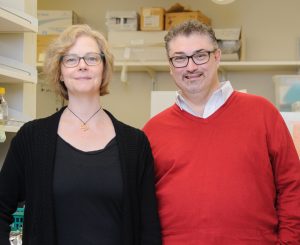
Researchers at The University of Alabama have shown a tiny worm can replicate genetic causes of Alzheimer’s disease, expanding the breadth of preclinical models for the disease.
“This is exciting because it validates the idea that we can use this simple system as a way to more rapidly tease out factors that might contribute to Alzheimer’s,” said Dr. Guy Caldwell, University Distinguished Research Professor.
Caldwell is co-author of a paper on the findings published in the journal Disease Models and Mechanisms. The work was supported by a Howard Hughes Medical Institute Collaborative Innovation Award.
Other co-authors include Dr. Kim Caldwell, UA professor of biological sciences, and Dr. Laura Berkowitz, UA lab manager and research associate. Also four other UA students were co-authors, including graduate students Samuel Scopel of St. Louis, Missouri; and Cayman Stephen of Lafayette, La.; along with undergraduate students Adam Holzhauer of Pontiac, Il.; Madeline Vaji of Cleveland, Ohio; and Ryan Tuckey of Middle Town, Maryland.
The Caldwells, along with their students, use tiny roundworms known as C. elegans, which share roughly half their genes with humans, to study human diseases. Its basic features allow inexpensive and rapid testing for a range of neurological diseases, as researchers can induce similar effects in the worm. They can be an important step in evaluating therapies in a chain of discovery from cells to animal models and, eventually, humans.
The worms have been used to study aspects of Alzheimer’s disease before, but now the UA researchers were able to show that humanized worms can be generated to emulate conditions seen in humans with genetic variation in a certain protein called Apolipoprotein E, or ApoE, for short.
“The worms recapitulate the clinical trend of Alzheimer’s risk seen in humans that harbor these heritable differences, therefore the new animal models open up the door to future mechanistic analyses and drug discovery,” Dr. Guy Caldwell said.
The exact cause of Alzheimer’s is unknown, but the effects of the disease on the brain include decreasing communication between the brain’s cells as neurons and their synapses are lost, leading to atrophy of part of the brain as the disease progresses. A person goes from short-term memory loss to dementia and eventual loss of bodily functions.
Afflicting nearly 30 million people worldwide, Alzheimer’s typically occurs in people older than 65, although early-onset Alzheimer’s does happen.
Learn more about this research by reading the full article on the UA news site.